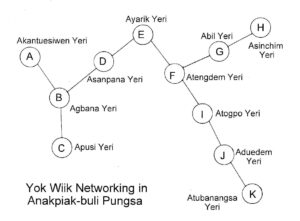Joseph Aduedem
Yog Wiik, a Traditional Mode of Information Dissemination
Introduction

Man shouting from a flat roof to another house
One thing I started missing as a result of schooling (and by that staying away from home) is the yog wiik, a traditional mode of dissemination of information in Buluk. Depending on the source of the information (the authority behind the communication), this has resulted into different names for this simple passing of information from house to house, namely; yog wiik (night call), naab wiik (chief’s call), etc. Even though in rare occasions the communication could be done at any time of the day, it usually occurs in the early hours of the night say 6:00 pm to 8:00 pm. And the calling was from one house to the other. Differently put, you would stand on top of your gbong (flat roof) and call out to the other person and he too would respond from his house.
On my part, it was a source of entertainment, because it seemed to have its own skills of communication. Thus, we used to hear things like: Yoooo Aduedemoooooooooo! It should be noted that the “yoooo” and the “ooooooooo” in mentioning Aduedem was (is) simply a display of enthusiastic shouting because you stand at your house to call out to the other person from his house. At the hearing of such a call, we used to be insulted when still talking. My grandfather would sound like this: “Nua gbegsa, ni guori chorototo, aba! Ba ni chali ani geni da dii dai (keep quite, these small mouths, one day they will run and leave you people behind). So the networking of this call was simply you climb and respond, and then also call out to the next house until every house gets the information.
The Authority behind the Message
The next thing to mention is who is the authority behind the message? In Sandema, mostly the communication comes from the paramount chief or Acham (Mr Shea tree). Acham is the personal name of a small shea tree located at Kandema in Sandema, considered to be powerful, and it is responsible for the general well-being of the whole Sandema. Because of this, it warns people who contract witches, ghosts, army worms, etc. to destroy the land to return them, less they receive his wrath.
The paramount chief uses (used) this method and, when it is coming from the palace, one can simply call it naab-wiik. And a naab-wiik mostly consists of calling all landlords (yeri nyam) to the palace, or announcing that some family members or some properties are missing or found], or everyone is called upon to tether their animals, and many more. In few cases we have the information coming from the kanbongnaab (sub-chief) and in that case, the communication is limited to that section alone.
In rare occasions, you have the communication coming from a landlord particularly where it had to do with disowning or renouncing a child of his, and this is known in Buli as wi basika. Thus the landlord calls out to the other houses within his clan and tells them that from that moment going, Mr Z is no longer his son. As stated already, this occurs very rarely.

Network calls starting in Akantuesiwen Yeri (A) and ending in Atubanangsa Yeri (K)
Disseminating the Message
The message will come after the other person has responded. It would usually be the reason for which the call is done. Let us use the name Azangbiok for an illustration
Caller: Yoooo Azangbiok woooooooooooo! (calling Mr Azangbiok)
Responder: Wa a siak yooooooooooooo! (responding “yes” to the call)
Caller: Naawa yen weeeeeeeeeeeeeeeee! Yeri-nyono yeri-nyono chum taam naab yeri siak yoooooo (Tomorrow every landlord should go to the palace to meet the chief).
Responder: Yooooooo! (noted)
From the above, the purpose of the message is to call all landlords to meet at the palace the following day.
The Binding Force of the Message
It suffices to say the binding effect of the message was immediate. This is because of the authority behind the message and failure to comply after the wiik has its consequences. Thus, we witnessed situations in the past where it concerned tethering livestock and immediately people complied by tethering their animals the following day. And in the case of worms or caterpillars or other things warned by Acham, the things started disappearing the subsequent days gradually.
Conclusion
Well, whether this traditional and old medium of passing information is still important or not is not the concern of the author for now. In as much as this practice is part of the life of the Bulsa as a people, I think it is worth writing about. Thus, truly, it might have outgrown its usefulness in the seeming presence of Radio Builsa in Sandema, Radio Fumbisi in Fumbisi, the use of mobile phones, and other Social Media platforms. However, as far as this has been part of the life experiences of the Bulsa as a people, the interest is to pen down that which or what our people relied on as far as passing information is concerned. And this is for posterity’s sake, that future generations get to know how previous generations disseminated information.
- Editorial
- Events
- Ghanatta Ayaric: Prof. S. Abanteriba awarded Medal of the Order of Australia (OAM)
- Franz Kröger House – Azantilow Senior High School, Sandema
- Franz Kröger: The Parliamentary and Presidential Elections 2020
- Franz Kröger, Robert Asekabta and Kennedy Azantilow : Electing New Bulsa Chiefs (2021-2022): Qualifications of a chief, elections in Fumbisi, Doninga, Kadema and Bachonsa
- Kennedy Azantilow and others: Feok Festival (and Associated Events) 2022
- Augustine Atano: Feok Festival 2020 (Review)
- Augustine Atano: The duration of the Feok Festival
- Augustine A. Atano: Feok Festival 2021 (Review)
- Kennedy Azantilow: Feok Festival 2022
- Franz Kröger: Who on Earth is Interested in the Bulsa?
- Franz Kröger: Obituaries
- Margaret Arnheim: Maaka in Buluk
- Martin Anbegwon Atuire: Bleeding Palimsests: Heritage Tourism…
- Kwesi Amoak: Review of Dr. Caesar Atuire’s “Philosophical Underspinnings of an African Legal System
- Joseph Aduedem: A Stranger in Her Own Land – The Position of Women in Bulsa Society
- Joseph Aduedem: Kisuta (taboos): Their Origins and Significance among the Bulsa
- Joseph Aduedem: Abunoruk maari Asuom / Abunoruk helped Asuom
- Joseph Aduedem: Yog Wiik
- Franz Kröger: The First Picture of an African Woman
- Franz Kröger: Recent Bulsa Publications
- Commentaries in the Internet Edition of Buluk
- Abdul-Rauf Akan-mwanatechaab: Brothers in Skirt
- John Agandin: The Fires Eat the Land at Home
- Bulsa Cuisine
- Ghanatta Ayaric: The New Masim Rice-Mill in Fumbisi